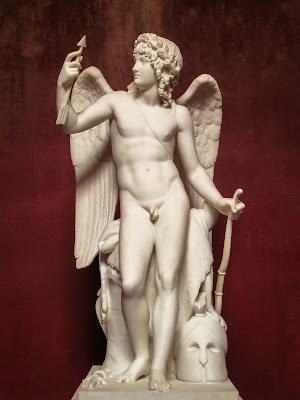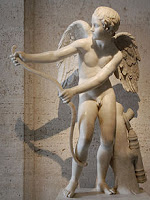Ven. Nyanatiloka (Buddhist Dictionary) edited by Wisdom Quarterly with Wiki edit
 |
| Erotic Greek Eros, Roman Cupid, Vedic/Buddhist/Jain/Hindu Kamadeva (wiki) |
 |
| Woman overcome by sensuality under Cupid's influence or control (chanteuse Lana Del Rey) |

Māra (literally "the killer"), is the Buddhist "Tempter"-figure, kind of Roman Cupid or Christian Lucifer.
He is often called "Māra the Evil One" (pāpimā māro) or Namuci (literally, "the non-liberator," i.e., the obstructor, the opponent of liberation).
 |
| Mara as Stewie as Cupid as Satan |
He appears in the sutras both as a real person (i.e., as a deity --
Kamadeva, the "god of love or sensuality," in Ancient Indian lore -- residing in a high Sensual Sphere heaven below Brahma just like Lucifer at the feet of God) and as the personification of death, harm/evil and passions, and of the totality of
samsaric existence.
 |
"Shiva Turns Kama to Ashes" Madan-Bhasma, cupidity destroyed (metmuseum.org).
|
- The name Kamadeva (kāma-deva) can be translated as "god of love." Kama (kāma) means "desire" or "longing," especially as in sensual or sexual love (eros). Deva means heavenly or divine, referring to general classes of beings superior in many ways to humans. The name is used in the Rig Veda (RV 9, 113. 11). Kamadeva is a name of Vishnu in the history Vishnu Purana and the Bhagavata Purana (SB 5.18.15) and of Krishna [the all-attractive Lucifer-like beauty Kanha, the very comely "Dark One"] as well as of Shiva.
- Kāmadeva [Cupid to the Romans] is represented as a young, handsome winged man with green skin [green is the color of the heart chakra] who wields a bow and arrow. His bow is made of sugarcane with a string of honeybees, and his arrows are decorated with five kinds of fragrant flowers. More
Later Pāli language literature often speaks of a "fivefold Māra" (pañca-māra):
 |
| The Roman god Cupid |
- Mara the deva or deity (māra-devaputta)
- Mara of the defilements (kilesa-māra)
- Mara of the aggregates (khandha-māra)
- Mara of the karma-formations (karma-māra)
- Mara as death (maccu-māra).
 |
| "I am your victim, Cupid" - Lana |
As a real person, Mara is regarded as the
deva ruling over the highest heaven of the Sensuous Sphere (
kāmā vacara)
, one of the three divisions of the universe, that of the "deities wielding power over the creations of others" (
paranimmitavasavatti-devas)
to be specific (Commentary to MN 1).
According to tradition, when the Bodhisatta (literally, the "Being bent on Enlightenment," i.e., the Buddha-to-be) was seated under the bodhi tree, Māra tried in vain to obstruct his attainment of
supreme enlightenment* -- first by frightening him with his hosts of "demons" (
yakshas,
rakshasas, ogres), and so on, then with his three seductive daughters' allurements.
- [*The kind of enlightenment, known as samma-sambodhi, that would enable him to effectively teach the Dharma that makes known to the practitioner the path to enlightenment and the liberation of nirvana.]
This episode in the life of the Buddha is referred to as "
Māra's War" (
māra-yuddha). For seven years Mara followed the Buddha, looking for any weakness in him, six years before his enlightenment and one year after it (Sn. v. 446).
Mara also tried to induce the Buddha to pass away into final nirvana (parinibbāna) without proclaiming and making known the Dharma, the teaching or path-of-practice that leads those who practice it to wisdom (enlightenment) and full liberation from all suffering (nirvana).
Mara again urged the Buddha toward final nirvana when the time for the Buddha's final passing away came. But the Buddha acted on his own insight in both cases. See DN 16.
For (3) Mara as
the aggregates, see S. XXIII, 1, 11, 12, 23. See the
Padhāna Sutra (Sn. v. 425ff.);
Māra Samyutta (S. IV).


 Māra (literally "the killer"), is the Buddhist "Tempter"-figure, kind of Roman Cupid or Christian Lucifer.
Māra (literally "the killer"), is the Buddhist "Tempter"-figure, kind of Roman Cupid or Christian Lucifer.




































































































































































































































No comments:
Post a Comment